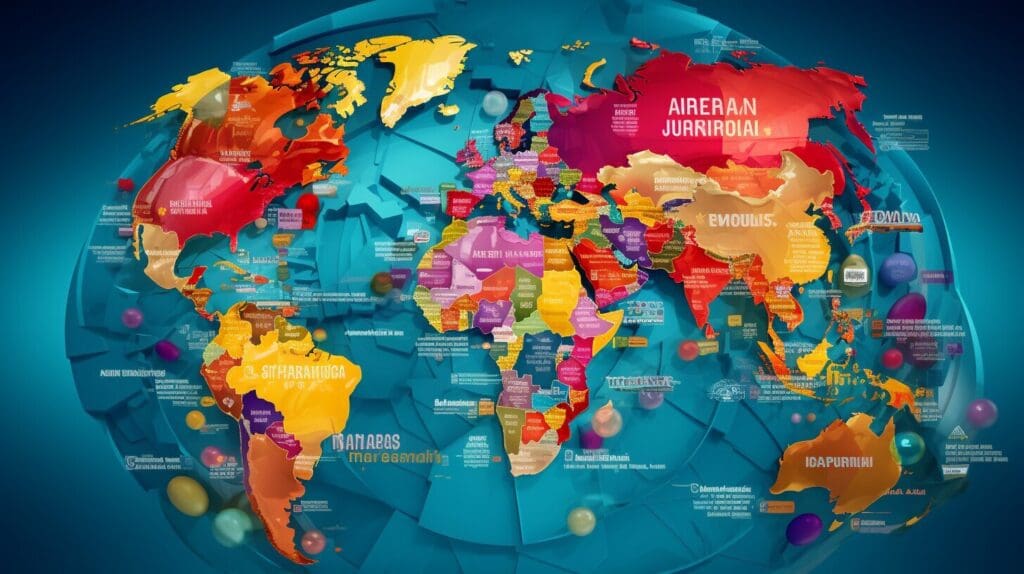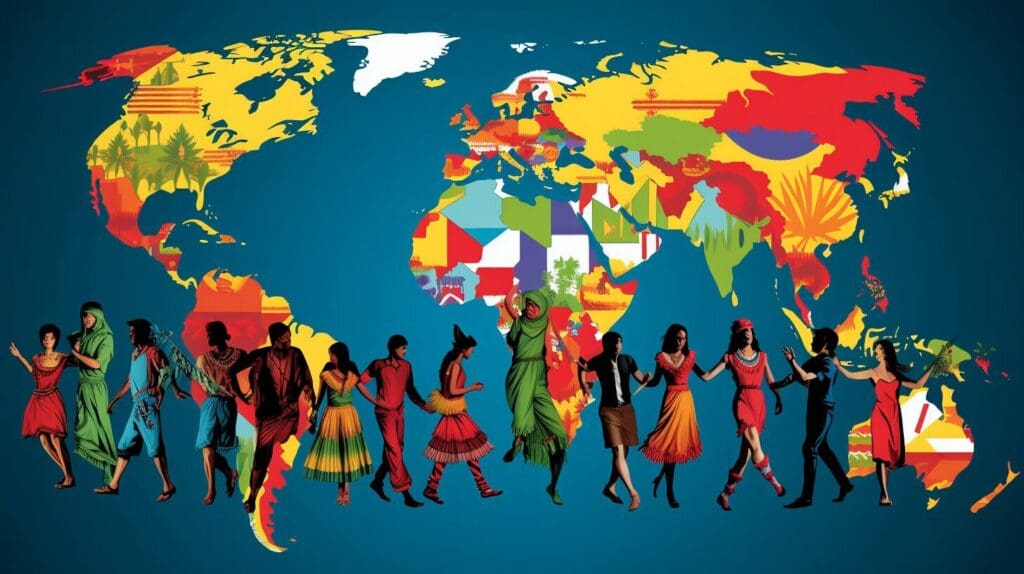Learning how to talk about countries and nationalities in Spanish is an essential skill for anyone looking to enhance their linguistic abilities. In this comprehensive guide, we will provide you with a list of countries and their corresponding nationalities in Spanish, along with useful vocabulary phrases. Whether you’re a beginner or an advanced learner, this article will help you develop your Spanish speaking skills.
Key Takeaways:
- Familiarize yourself with the vocabulary for countries and nationalities in Spanish.
- Understand the grammar rules for nationalities in Spanish, including gender agreement and singular/plural forms.
- Practice using phrases for discussing nationalities in Spanish.
- Explore the specific countries and nationalities in Latin America, Europe, Asia, Africa, and other regions.
- Learn about the Spanish-speaking countries and their nationalities to broaden your understanding of the language.
Understanding Grammar Rules for Nationalities in Spanish
When it comes to discussing countries and nationalities in Spanish, it’s important to understand the grammar rules that apply. These rules govern gender agreement, singular and plural forms, and capitalization. By familiarizing yourself with these grammar rules, you can communicate accurately and confidently in Spanish.
Gender Agreement
One of the key aspects of Spanish grammar is gender agreement. In Spanish, both the country and the nationality must agree in gender with the subject being referred to. For example, if you’re talking about a male person from Spain, you would say “español“; whereas if you’re talking about a female person from Spain, you would say “española”. It’s essential to pay attention to the gender of the subject when using nationalities in Spanish.
Singular and Plural Forms
In addition to gender agreement, nationalities in Spanish can also be singular or plural. The singular form is used when referring to one person, while the plural form is used when referring to more than one person. For example, “francés” (singular) means “French” (masculine), whereas “franceses” (plural) means “French” (masculine plural). It’s important to use the correct form based on the number of people being referred to.
Capitalization
Capitalization is another aspect to keep in mind when discussing nationalities in Spanish. In general, country names are capitalized, while nationalities are not. For example, “España” (Spain) is capitalized, but “español” (Spanish) is not. This distinction is important to ensure proper grammar and writing conventions in Spanish.
By understanding these grammar rules for nationalities in Spanish, you’ll be able to express yourself accurately and confidently when talking about countries and nationalities. Practice using these rules in conversation and writing to further enhance your Spanish language skills.
| Country | Male Nationality | Female Nationality |
|---|---|---|
| España | español | española |
| Francia | francés | francesa |
| Alemania | alemán | alemana |
| Italia | italiano | italiana |
| Estados Unidos | estadounidense | estadounidense |

Spanish Vocabulary for Countries and Nationalities
When learning to talk about countries and nationalities in Spanish, it’s essential to have a solid vocabulary foundation. Here is a comprehensive list of countries and their corresponding nationalities in Spanish to help you expand your linguistic skills:
| Country | Nationality |
|---|---|
| Mexico | mexicano/mexicana |
| Spain | español/española |
| Argentina | argentino/argentina |
| United States | estadounidense |
| Brazil | brasileño/brasileña |
| France | francés/francesa |
| Germany | alemán/alemana |
| Italy | italiano/italiana |
| China | chino/china |
Use this table as a reference when practicing conversations about countries and nationalities in Spanish. Remember to pay attention to gender agreement and singular/plural forms when discussing nationalities. By incorporating these vocabulary words into your language learning, you’ll be able to communicate more effectively and fluently.
Practice using these words in sentences to further solidify your understanding. For example, “Soy mexicano” means “I am Mexican,” and “Ella es española” means “She is Spanish.” Keep practicing and exploring additional countries and nationalities to enhance your Spanish speaking skills.
Discussing Nationalities in Spanish
When engaging in conversations about nationalities in Spanish, it is important to know the relevant phrases and vocabulary. By using the correct expressions, you can communicate effectively and accurately convey the desired information. Here are some useful phrases for discussing nationalities in Spanish:
- ¿De dónde eres? – Where are you from?
- Soy de [país] – I am from [country]
- ¿Cuál es tu nacionalidad? – What is your nationality?
- ¿Cómo se dice [nationality] en español? – How do you say [nationality] in Spanish?
- Me gustaría aprender más sobre la cultura de tu país – I would like to learn more about the culture of your country
Using these phrases will help you start conversations about nationalities and create a positive and engaging dialogue with native Spanish speakers.
Example Conversation:
Person A: ¡Hola! ¿De dónde eres?
Person B: Soy de México.
Person A: ¡Qué interesante! Me gustaría aprender más sobre la cultura mexicana. ¿Cuál es tu nacionalidad?
Person B: Soy mexicano/a.
Person A: ¡Muy bien! ¿Cómo se dice “Mexican” en español?
Person B: “Mexicano”.
Person A: ¡Gracias! Me encantaría visitar México algún día y conocer más sobre su cultura y tradiciones.

| English | Spanish |
|---|---|
| Nationality | Nacionalidad |
| Country | País |
| Where are you from? | ¿De dónde eres? |
| What is your nationality? | ¿Cuál es tu nacionalidad? |
| I am from [country] | Soy de [país] |
| How do you say [nationality] in Spanish? | ¿Cómo se dice [nationality] en español? |
Latin American Countries and Nationalities in Spanish
Latin America is a region rich in culture, history, and diversity. When learning Spanish, it is essential to familiarize yourself with the countries and nationalities in this vibrant part of the world. Here is a comprehensive list of Latin American countries and their corresponding nationalities in Spanish:
| Country | Nationality |
|---|---|
| Mexico | Mexicano/a |
| Argentina | Argentino/a |
| Brazil | Brasileño/a |
| Colombia | Colombiano/a |
| Peru | Peruano/a |
| Chile | Chileno/a |
| Costa Rica | Costarricense |
| Venezuela | Venezolano/a |
Learning the Spanish vocabulary for these Latin American countries will not only enhance your language skills but also deepen your understanding of the diverse cultures and histories that make up this fascinating region. Practice using these nationalities in sentences to further strengthen your language proficiency.
Exploring Latin American Cultures
Each Latin American country has its own unique culture and traditions. Take the opportunity to delve into the various aspects that define these nations. From music and dance, such as salsa in Cuba and tango in Argentina, to mouth-watering cuisine like tacos in Mexico and empanadas in Colombia, there is so much to discover.
Immerse yourself in Latin American literature, films, and art to gain a deeper appreciation for the creativity and talent that emerges from this region. By embracing the cultures of Latin America, you’ll not only expand your Spanish language skills, but you’ll also develop a greater understanding and appreciation for the rich tapestry of this part of the world.

Continue your language journey and explore the other regions we will cover in this article to further enrich your Spanish-speaking abilities.
European Countries and Nationalities in Spanish
Europe is a continent known for its rich history, diverse cultures, and stunning landscapes. When it comes to discussing European countries and nationalities in Spanish, it’s important to familiarize yourself with the vocabulary and grammar rules specific to this region. By learning the Spanish names for European countries and their corresponding nationalities, you’ll be able to confidently talk about Europe in your conversations.
To help you navigate this topic, here is a comprehensive table showcasing some of the most commonly talked about European countries and their respective nationalities in Spanish:
| European Country | Nationality in Spanish |
|---|---|
| Spain | español/a |
| France | francés/francesa |
| Germany | alemán/alemana |
| Italy | italiano/italiana |
| United Kingdom | británico/británica |
It’s important to note that nationalities in Spanish, like most adjectives, must agree in gender with the person being referred to. For example, if you’re talking about a male individual from Spain, you would say “español.” If you’re referring to a female individual, you would use “española.”
By expanding your Spanish vocabulary to include European countries and nationalities, you’ll be able to engage in meaningful conversations about this fascinating region. Practice using these words in sentences and immerse yourself in the rich cultural heritage of Europe through your language learning journey.

Asian Countries and Nationalities in Spanish
Asia is a continent teeming with diverse countries and cultures. In this section, we will explore the different countries and nationalities in Asia and provide you with the Spanish vocabulary to discuss them. By expanding your knowledge of Asian countries and their corresponding nationalities in Spanish, you’ll gain a deeper understanding of this vibrant region. Let’s dive in!
Asian Countries and their Nationalities in Spanish
To start, here is a table showcasing Asian countries and their corresponding nationalities in Spanish:
| Country | Nationality |
|---|---|
| Japón | japonés/japonesa |
| China | chino/china |
| Corea del Sur | surcoreano/surcoreana |
| Tailandia | tailandés/tailandesa |
| India | indio/india |
These are just a few examples of the many countries in Asia and their nationalities. As you continue to learn Spanish, explore more Asian countries and their nationalities to expand your vocabulary and cultural understanding.
Learning the Spanish vocabulary for Asian countries and nationalities opens up opportunities to connect with Spanish-speaking individuals from Asia, as well as engage in discussions about Asia’s rich heritage, traditions, and people. Whether you’re planning a trip to Asia or simply interested in broadening your linguistic horizons, this knowledge will undoubtedly enrich your Spanish-speaking experience.

Continue practicing your language skills and exploring the diverse world of Spanish-speaking countries and nationalities. By immersing yourself in the linguistic and cultural aspects of different regions, you’ll become a more confident and proficient Spanish speaker.
African Countries and Nationalities in Spanish
Africa is a diverse continent with numerous countries and nationalities. Learning the Spanish vocabulary for these African countries will expand your knowledge and understanding of the African continent. In this section, we will explore a list of African countries and their corresponding nationalities in Spanish.
Below is a table showcasing African countries and their nationalities in Spanish:
| African Country | Nationality in Spanish |
|---|---|
| Egypt | egipcio/a |
| South Africa | sudafricano/a |
| Nigeria | nigeriano/a |
| Kenya | keniano/a |
| Ethiopia | etíope |
| Ghana | ghanés/esa |
| Algeria | argelino/a |
| Senegal | senegalés/esa |
| Cameroon | camerunés/esa |
| Tanzania | tanzano/a |
By familiarizing yourself with these African countries and their nationalities in Spanish, you’ll be able to engage in conversations and communicate effectively with people from Africa.
Other Countries and Nationalities in Spanish
Aside from the well-known regions mentioned earlier, there are numerous other countries and nationalities in Spanish that are worth exploring. These countries span across various continents and offer a diverse range of cultures and languages. Here is a list of some lesser-known countries and their corresponding nationalities in Spanish:
| Country | Nationality |
|---|---|
| Greece | Griego/a |
| India | Indio/a |
| Japan | Japonés/japonesa |
| Russia | Ruso/a |
| Australia | Australiano/a |
| Canada | Canadiense |
By familiarizing yourself with the vocabulary for these countries and nationalities, you’ll be able to engage in conversations with people from different backgrounds and expand your cultural knowledge. Practice using these words in sentences to further improve your Spanish language skills.
It’s important to note that this is just a small selection of the many other countries and nationalities in Spanish. The world is full of diverse cultures, and learning the corresponding Spanish vocabulary can greatly enhance your ability to communicate across borders. Whether you’re interested in exploring African, Asian, European, or other countries, diving into the Spanish vocabulary for other countries and nationalities will open up a world of possibilities.
So, take the time to explore the lesser-known countries and nationalities in Spanish. Broaden your horizons, embrace the rich linguistic diversity, and continue your journey towards becoming a confident Spanish speaker.
Spanish-speaking Countries
As a Spanish learner, it’s important to be familiar with the Spanish-speaking countries and nationalities. Being able to communicate with people from these countries not only enhances your language skills but also allows you to connect with a wider range of Spanish speakers around the world.
Below is a list of Spanish-speaking countries along with their corresponding nationalities:
| Country | Nationality |
|---|---|
| Mexico | Mexican |
| Spain | Spanish |
| Argentina | Argentine |
| Colombia | Colombian |
| Peru | Peruvian |
| Venezuela | Venezuelan |
| Chile | Chilean |
| Ecuador | Ecuadorian |
| Guatemala | Guatemalan |
Learning the Spanish vocabulary for these countries and nationalities will allow you to engage in meaningful conversations with native Spanish speakers. It’s also worth noting that each Spanish-speaking country has its own unique culture and dialect, adding richness to the language and providing an opportunity for cultural exploration.
So, whether you’re planning to travel to a Spanish-speaking country or simply want to expand your language skills, make sure to familiarize yourself with the Spanish-speaking countries and their nationalities. Building your knowledge in this area will not only enhance your proficiency in Spanish but also deepen your understanding of the diverse Spanish-speaking world.

Conclusion
In conclusion, this comprehensive guide has provided you with the essential knowledge and vocabulary to confidently talk about countries and nationalities in Spanish. By understanding the grammar rules and expanding your vocabulary, you can effectively communicate with native Spanish speakers on this topic. Remember to practice using the phrases and examples provided to improve your conversational skills.
Key takeaways from this article include the importance of gender agreement and singular/plural forms when discussing nationalities in Spanish. Additionally, capitalization rules for country names and nationalities should be adhered to. By paying attention to these details, you can accurately express yourself and avoid misunderstandings.
Whether you’re a beginner or an advanced learner, mastering the vocabulary and grammar related to countries and nationalities in Spanish is a crucial step towards fluency. Keep practicing, exploring the diversity of Spanish-speaking countries, and engaging in conversations to enhance your language skills and cultural understanding.
FAQ
How can I talk about countries and nationalities in Spanish?
To talk about countries and nationalities in Spanish, you need to understand the grammar rules and use the correct vocabulary. By practicing conversations and expanding your vocabulary, you’ll be able to confidently discuss countries and nationalities in Spanish.
What are the grammar rules for nationalities in Spanish?
Nationalities in Spanish must agree with the gender of the subject and can be singular or plural depending on the number of people being referred to. Additionally, capitalization rules differ between country names and nationalities.
Can you provide a list of countries and their corresponding nationalities in Spanish?
Yes, we have a comprehensive list of countries and their corresponding nationalities in Spanish. By learning these vocabulary words, you’ll be able to talk about countries and nationalities with ease.
How can I discuss nationalities in Spanish?
To discuss nationalities in Spanish, it’s important to use the correct vocabulary and grammar. By learning phrases and examples, you’ll be able to engage in conversations about nationalities with Spanish-speaking people during your future travels.
What are some useful phrases for discussing nationalities in Spanish?
We have provided phrases and examples of how to talk about nationalities in Spanish. By learning these phrases, you’ll be able to confidently discuss nationalities with Spanish-speaking people.
Can you provide a list of Latin American countries and their nationalities in Spanish?
Yes, we have a list of Latin American countries and their nationalities in Spanish. By expanding your knowledge of these countries and their nationalities, you’ll have a better understanding of the Spanish-speaking world.
What about European countries and their nationalities in Spanish?
We also have a list of European countries and their nationalities in Spanish. Learning the Spanish vocabulary for these European countries will allow you to discuss Europe and its diverse cultures in Spanish.
How can I talk about Asian countries and nationalities in Spanish?
This section provides a list of Asian countries and their nationalities in Spanish. By learning the Spanish vocabulary for these Asian countries, you’ll be able to discuss Asia and its rich heritage in Spanish.
Are there lists of African countries and their nationalities in Spanish?
Yes, we have a list of African countries and their nationalities in Spanish. By expanding your knowledge of the Spanish vocabulary for these African countries, you’ll gain a greater understanding of the African continent.
Are there any other countries and nationalities to learn in Spanish?
Besides the regions mentioned above, there are many other countries and nationalities to learn in Spanish. This section covers countries and nationalities from various other regions around the world.
Can you provide a list of Spanish-speaking countries and their nationalities?
Yes, we have a list of Spanish-speaking countries and their corresponding nationalities. By learning about these countries and nationalities, you’ll develop a deeper understanding of the Spanish language and its global reach.

